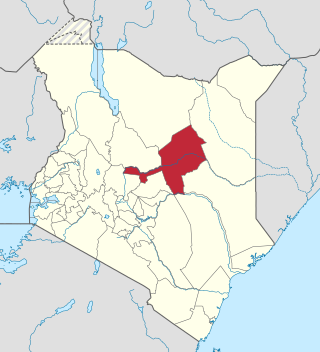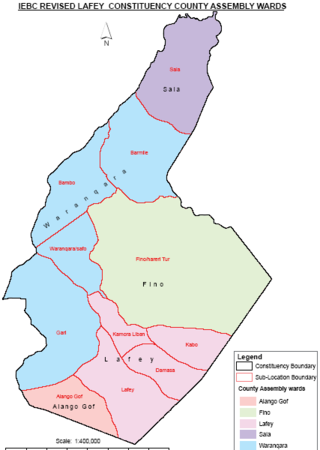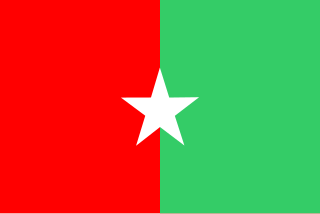
The North Eastern Province is one of the former provinces of Kenya. It had a land area of 127,358.5 km2, with its capital at Garissa. The North Eastern Province was carved out of the then Northern Frontier District (NFD) prior to independence.
The Garre are a prominent Somali clan that traces its lineage back to Samaale, who is believed to have originated from the Arabian Peninsula through Aqiil Abu Talib. The Garre clan is considered to be a sub-clan of the Digil-Rahanweyn clan family, which is part of the larger Rahanweyn clan. However, genealogically, they are descended from Gardheere Samaale. The Garre are also categorized as southern Hawiye as well.
Rioja is the capital of Rioja Province in the San Martín Region in northern Peru. It is situated to the west of Moyobamba. There are 24,263 inhabitants according to the 2007 census.
The Ogaden is one of the major Somali clans.

Isiolo County is a county in the former Eastern Province of Kenya. Its population is 268,002 and its capital and largest city is Isiolo. Isiolo County is to be the first county to be developed as part of the Kenya Vision 2030 program. Other upcoming urban centres are: Garbatulla, Modogashe, Kinna, Merti and Oldonyiro.The county is home to Sakuye and Borana tribes but also has a significant number of people from Turkana, Samburu, Gabra, Garre and Meru communities.
Dolo Addo or Dolo Ado or Dollo Ado is one of the woredas in the Somali Region of Ethiopia. Part of the Liben Zone, Dolo Ado is located in the angle formed by the confluence of the Ganale Dorya with the Dawa River, and bordered to the northwest by Filtu, on the northeast by Afder Zone, on the southeast by Somalia, and on the south by Kenya. Towns in Dollo Ado include Koole,*Helaweyn,And #Buur,Dolo and Suftu. It is home to Garimarro and Degodia who are living in dollo ado

Garissa County is an administrative county in Kenya. It is located in Eastern Kenya bordering Somalia to the East, Wajir County and Isiolo County to the North, Tana River County to the West and Lamu County to the South. Its capital and largest urban area is Garissa.

Wajir County is a county in the former North Eastern Province of Kenya. Its capital and largest town is Wajir. The county has a population of 781,263 and an area of 55,840.6 km2 (21,560.2 sq mi). The county is bordered to the north by Ethiopia, to the northeast by Mandera County, to the east by Somalia, to the south by Garissa County, to the west by Isiolo County and to the northwest by Marsabit County. The county has six constituencies: Wajir South, Tarbaj, Wajir North, Wajir West, Wajir East, and Eldas.
El Wak, also Elwak is a town in Kenya, on the International border with Somalia. The name El Wak translates into "the well of God". There are about 50 wells spread across the town, each approximately 60 feet deep with interconnected underground passages.
Kibigori is a small town in Kisumu County, Kenya. It is located 20 kilometres east of Kisumu. It is part of the Chemelil ward of Muhoroni Constituency and Nyando County Council. Elevation 1242m.
Busitema is a settlement in eastern Uganda. It is the location of the Main Campus of Busitema University, one of the public universities in Uganda.
Wajir South Constituency is a electoral constituency in Kenya. Wajir South is one of the six constituencies in Wajir County and one of the largest in Kenya. It is also one of the most neglected, underdeveloped, and unchanged constituencies in Kenya since its creation. The constituency IEBC data shows Wajir South land mass is about 21,424 sq km, hence larger than Central (11,449), Nairobi (696) and Western (7,400) regions combined. The constituency has seven wards Burder Ward, Dadajabula, Ibrahim ure, Diif, Lagboqol south, Habaswein, and Banane ward, all electing Members of County Assembly(MCA) to the Wajir County Assembly. On 27th September 2023, leaders from Wajir South Constituency led by area Mp Mr. Mohamed Adow submitted a memorundum proposing the creation of Wajir South County to the National Dialogue Committee at the Bomas of Kenya in Nairobi. This was sparked by the inequitable distribution of Wajir County resources and allocation of county jobs with Wajir South getting a paltry 5.33% and 4.19% respectively despite accounting 40% of Wajir County.

Lafey Constituency is a constituency in Mandera County, Kenya. It is one of six constituencies in the county. The town of Lafey is the capital of the constituency, and is located at around 3°55′N 41°50′E / 3.917°N 41.833°E, near the border with Somalia.
Wajir Airport is an international airport in Wajir County, Kenya.

Somalis in Kenya are citizens and residents of Kenya who are of Somali ethnic descent. They have historically inhabited the North Eastern Province, previously called the Northern Frontier District, which was carved out of the Jubaland region of present-day southern Somalia during the colonial period. Following the civil war in Somalia that broke out in 1991, many Somalis sought asylum in the Somali-inhabited enclaves of Kenya. An entrepreneurial community, they established themselves in the business sector, particularly in the Nairobi suburb of Eastleigh.
Buna is a small town and Sub-County in Wajir County, situated in the North Eastern Province in Kenya. Nearby towns and places include Ajao and Bute Helu.
Rhamu, known to the locals as "shantooley", is a town in the Mandera County of Kenya situated in the northeastern part of Kenya, approximately 15 kilometers east of the River Dawa. The town lies within a semi-arid region characterized by dry and hot conditions, with limited rainfall and sparse vegetation. It is largely populated by the Garre and Murule Somali as well as a substantial settlement of Degodia clan on the north western side. The town was previously built by the british colonial administration and was the border between Quranyow-Banna section of the Garre tribe and Murule Rhamu is located at the international border between Kenya and Ethiopia. Due to its proximity to Ethiopia, Rhamu has historically been a center for cross-border trade. Local traders engage in the exchange of goods, including livestock, agricultural products, and other commodities with their Ethiopian counterparts.
Lafey is a town and sub-county in the Mandera County of Kenya. It sits in the northeast part of the country, at the international border with Somalia.
Saransoor is a Somali Samaale clan family, among the largest by population and by area, inhabiting a traditional territory in Somalia spanning from Qorahsin, Hiran, to Ras Kamboni, Lower Jubba. In Kenya's North Eastern Province, Saransor make up the majority of the inhabitants of Wajir and have a significant presence in Mandera County they also have large population in Marsabit County and Isiolo County and Nairobi. In Ethiopia, a majority of the population of Liben Zone is Saransor they have very large population in Afdher, Dollo, Shabelle, Jarar, Dira Dawa and Jijiga.
Burder Ward is an electoral ward of Wajir South Constituency in Wajir County Kenya. Burder Ward is one of the seven wards in Wajir South Constituency of Wajir County. It is also one of the most neglected, underdeveloped, and unchanged wards in wajir south since its creation. A mega failure by successive members of Parliament. Despite the billions of devolved funds pumped into wajir county over the past 12 years, water remains a scarce resource to the residents of the ward.The Ward has 18 settlement and locations.









